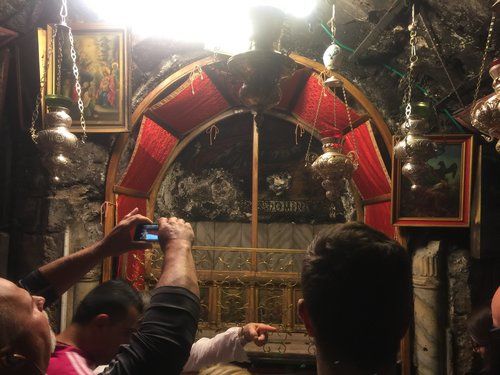Imagine Being Born in a Cave Full of Cow Manure

Whenever we sanitize the nativity scene, we strip away the incredible power of the Christmas story.
When we think of Jesus’ birth, we usually picture an adorable baby Jesus laying on golden straw, surrounded by Mary and Joseph, some cute lambs, a donkey and a few friendly shepherds, all lit by the warm glow of a lamp.
We do this because while we know that Jesus’ first century birth was not clean or sanitary by modern standards, we want it to look as warm, and as inviting as possible.
However when we clean up the story of Jesus’ birth like this, we risk sanitizing the Good News.
When we think of Jesus’ birth, we usually picture an adorable baby Jesus laying on golden straw, surrounded by Mary and Joseph, some cute lambs, a donkey and a few friendly shepherds, all lit by the warm glow of a lamp.
We do this because while we know that Jesus’ first century birth was not clean or sanitary by modern standards, we want it to look as warm, and as inviting as possible.
However when we clean up the story of Jesus’ birth like this, we risk sanitizing the Good News.

The reality is that in First Century Israel, shepherds kept their flock in dank caves where the ground would have been thick with centuries of manure and the walls would have been caked in bird-droppings from all the nests built into the crevices.
The cave where Jesus was most likely born would have smelt like wet mold, mixed with sheep manure. Most of us would have gagged when we walked in.
In fact, the Hebrew word for "sheepfold" where the authors of the Christmas story say Jesus was born, is "miklaah" (מכלאה, pronounced "mik-law-aw"), which shares the same root as the Hebrew word for cave!
There was no golden hay, no warm light—just damp, cold rock and stench … but THIS is where our hope was born!
The cave where Jesus was most likely born would have smelt like wet mold, mixed with sheep manure. Most of us would have gagged when we walked in.
In fact, the Hebrew word for "sheepfold" where the authors of the Christmas story say Jesus was born, is "miklaah" (מכלאה, pronounced "mik-law-aw"), which shares the same root as the Hebrew word for cave!
There was no golden hay, no warm light—just damp, cold rock and stench … but THIS is where our hope was born!

As Andy Stanley once said, the nativity was “… 99% chaos and 1% hope. But without the chaos we would miss the hope.”
And this is why we should stop sanitizing the nativity scene. I want to always remember that Jesus willingly and literally stepped into the crap of our lives, so that we could live in heaven!
At Christmas, I’m always reminded that there are a thousand times in history when a baby became a king—but there’s only one time that a King became a baby.
And this is why we should stop sanitizing the nativity scene. I want to always remember that Jesus willingly and literally stepped into the crap of our lives, so that we could live in heaven!
At Christmas, I’m always reminded that there are a thousand times in history when a baby became a king—but there’s only one time that a King became a baby.

Posted in God
Recent
Archive
2023
2022
January
February
April
2021
May
June
August
October
November
